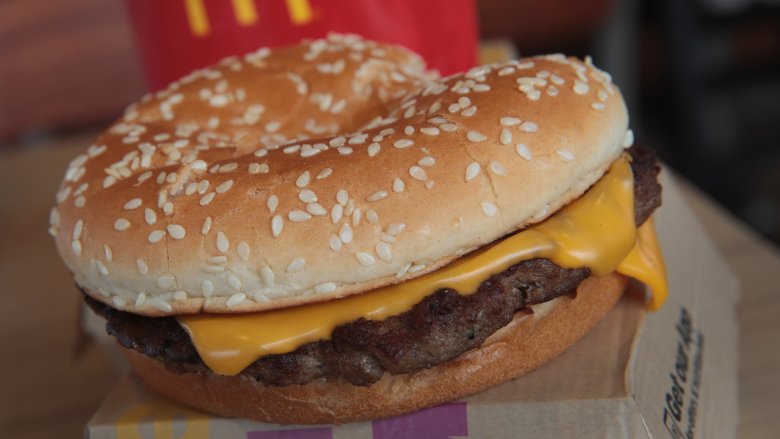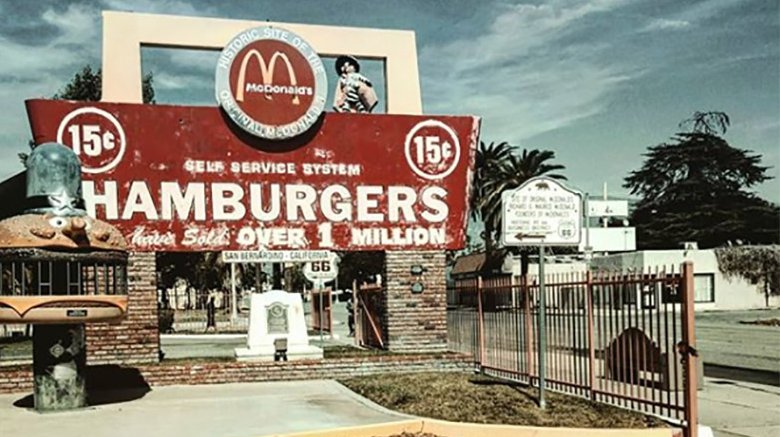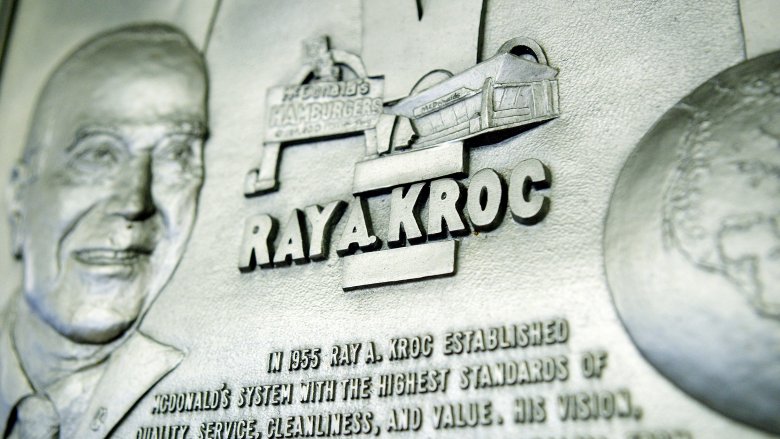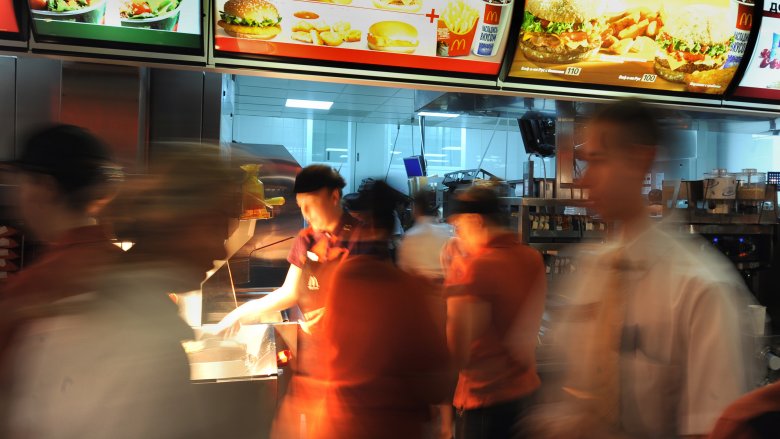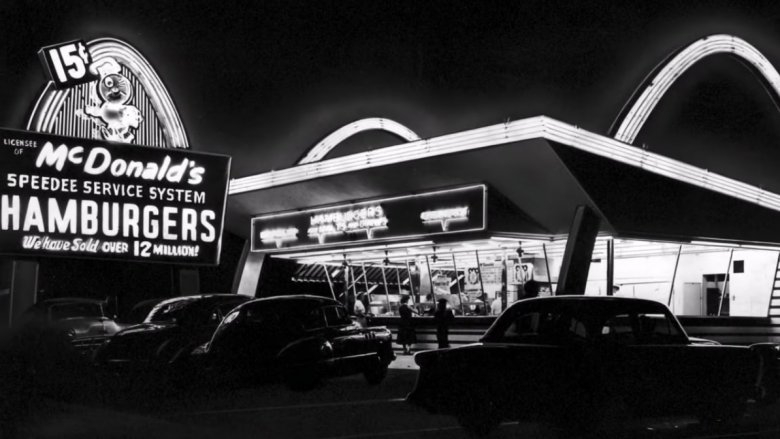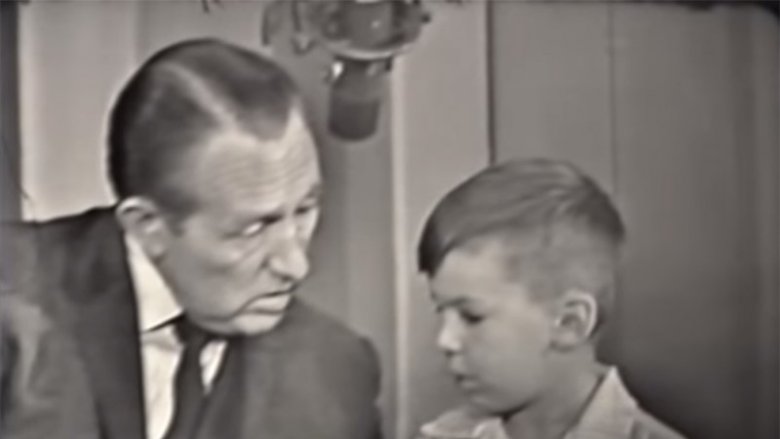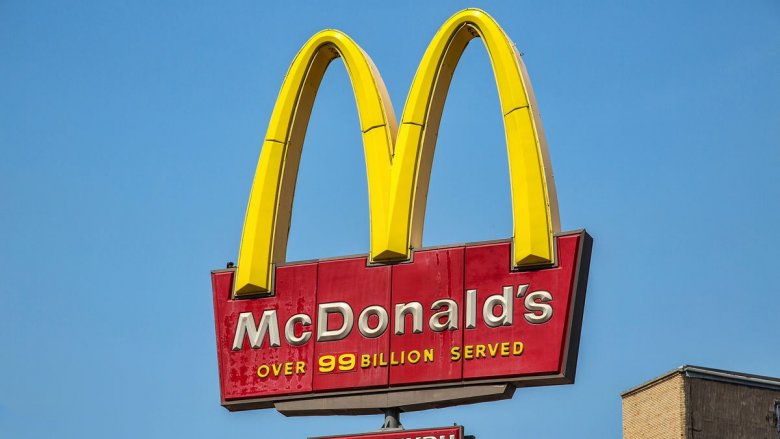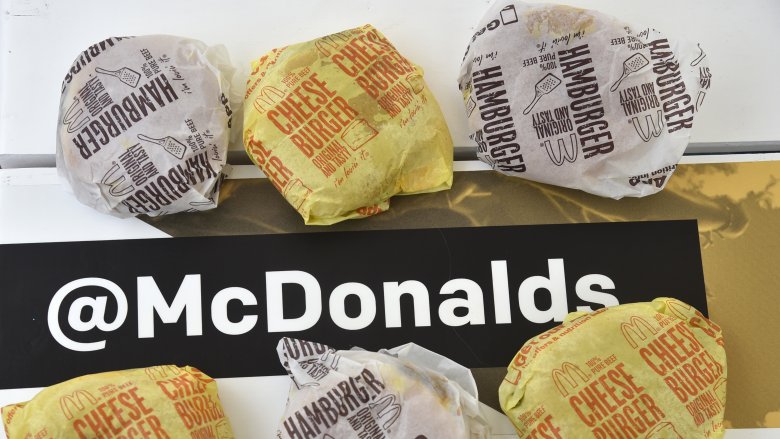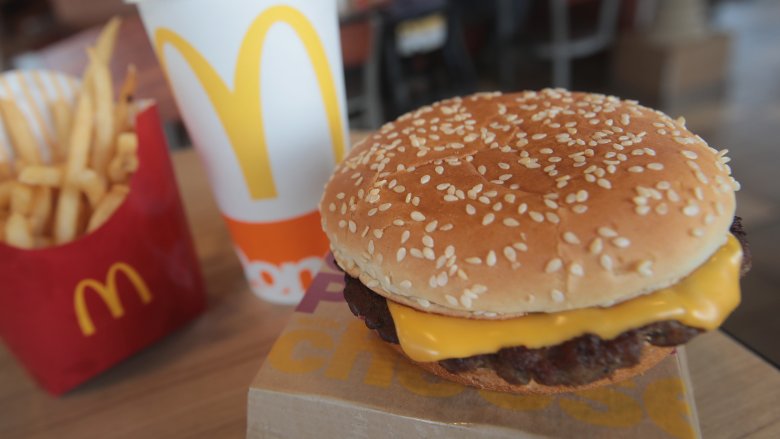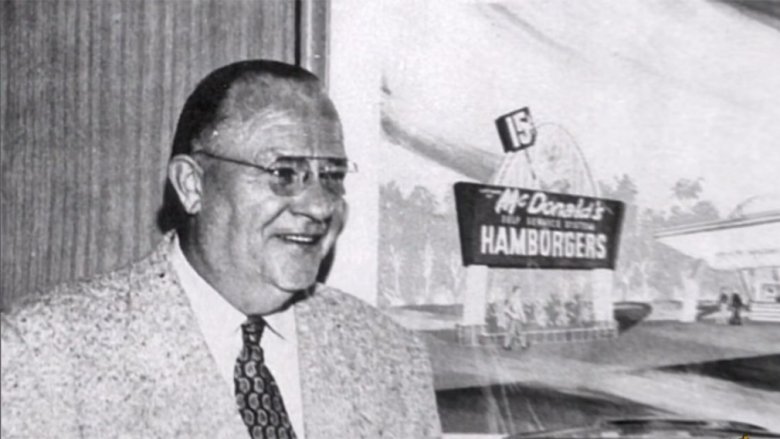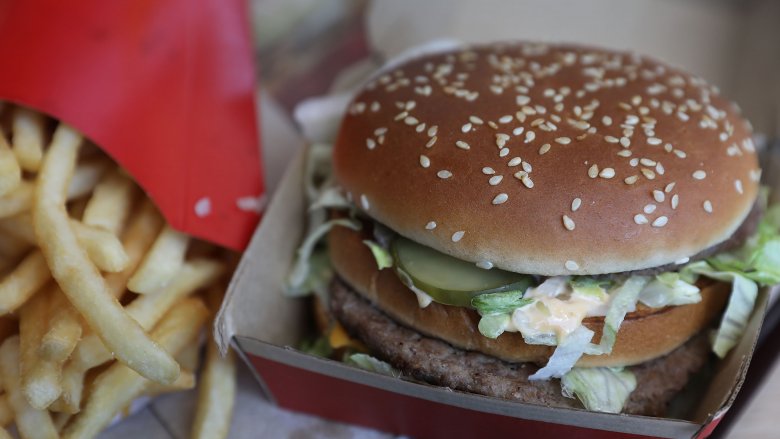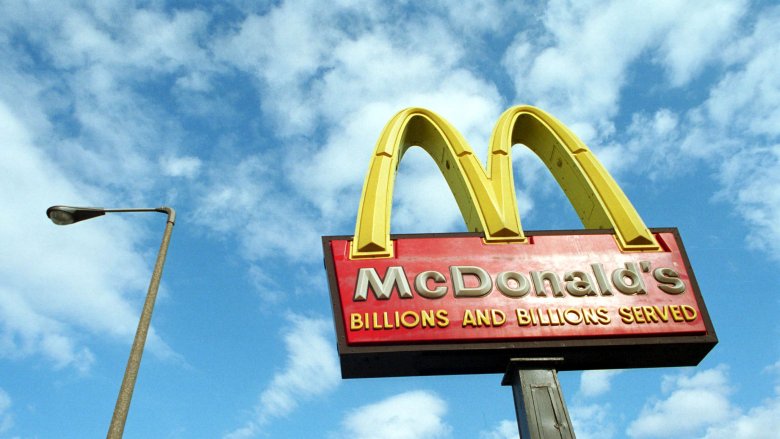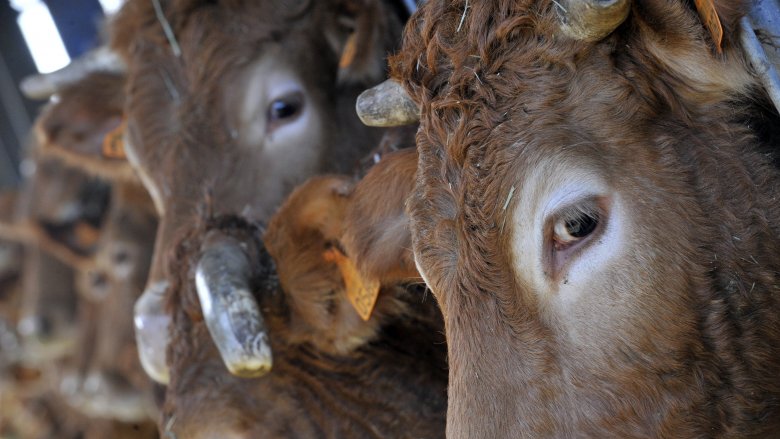The Truth About How Many Burgers McDonald's Has Sold
"I put the hamburger on the assembly line" — Ray Kroc.
Those words from Ray Kroc ring shockingly true when you take a moment to think about just how popular McDonald's is around the world. McDonald's may not be picking up a ton of accolades for having the best burger in the world, but they certainly make up for it with quantity. You don't see any other fast food restaurants bragging about selling a billion burgers on their signs. Those burger stats have been part of McDonald's identity for decades though — even if those numbers have remained rather stagnant for some time (but we'll get to that later).
Just how many millions and billions of hamburgers has McDonald's sold over the years? Obviously, it's a lot, but let's get down to the nitty gritty with the numbers of this global burger machine. From how many burgers are sold a second, to how McDonald's moves its product so quickly, and who came up with the burger count on the sign idea, here's everything you ever wanted to know about the Golden Arches and their burger boasting.
McDonald's started tracking its burger sales early on
The number of burgers sold has certainly skyrocketed since the first San Bernardino, California, McDonald's opened, but the restaurant group has been boasting of its burger sales since its earliest days. Dick McDonald is credited with coming up with both the idea for McDonald's golden arch logo as well as the burger counter that went along with it.
In 1948, the McDonald brothers closed their small barbecue stand, and did an overhaul of the food preparation and serving process. When it reopened, barbecue was out and burgers, fries, and shakes were in. Sales were slow at first, but after a few months customers began coming in droves. To mark the food's popularity, the brothers put up a painting of a red thermometer in the restaurant's window. Sales soon hit 1,000 burgers and when the millionth hamburger sale came in, the plan was to have the artist mark the occasion with a painted explosion at the top of the thermometer.
It wasn't long before the press and public took notice either. A 1952 story by the trade journal American Restaurant, touted McDonald's popularity and efficiency, revealing that the business was dishing out "one million hamburgers and 160 tons of french fries a year."
A million burgers a year is now of course small potatoes, and once Ray Kroc came on board to make McDonald's a national sensation burger sales would soar dramatically higher.
Burger sales exploded when Ray Kroc came onboard
McDonald's was chugging along fine as a small chain of restaurants in the early 1950s. Food sales were in the millions and the brothers were making enough money to buy themselves brand new Cadillacs — the burger count was growing quickly.
It was in 1954 though that everything really changed and the brothers went into a business with Ray Kroc, a milkshake salesman who envisioned McDonald's moving well beyond the West Coast. Under his drive to expand, McDonald's burger sales exploded. By the time Kroc opened his first McDonald's location in Del Plaines, Illinois, in 1955, McDonald's boasted that it had sold over 15 million burgers — only seven years after the McDonald brothers re-opened their humble burger stand. It was the first McDonald's location east of the Mississippi river, and after that, the fast food restaurants (and burger sales) began spreading like wildfire.
By 1958, McDonald's had expanded significantly and sold 100 million burgers with Kroc on the team. Just two years later, Kroc had pushed that number to 400 million. More locations of course meant a lot more burgers and Kroc wasn't shy about his role in elevating McDonald's burger sales, even bragging "I didn't invent the hamburger. I just took it more seriously than anyone else."
Around 75 burgers are sold every second
Everybody knows that McDonald's sells a lot of hamburgers. Figuring out just how many hamburgers they sell not by the day or even the hour, but by the second, seems like a near impossible exercise that only the most math-inclined of burger nerds would take on. Somebody did figured it out though, and in 2013 the fast food giant was reportedly moving around 75 burgers every second. This burger data roughly breaks down as 4,500 burgers every minute, 270,000 every hour, 6.48 million every day, and 2.36 billion burgers every year.
Other estimates have put McDonald's burger sales at 50 million a day — worldwide at least. In 2018, McDonald' had around 13,900 U.S. locations, which was a drop from its peak at 14,350 restaurants in 2014. So while it's possible they may not be selling quite as many burgers a second as they were a few years go, it's fair to say they're still moving a lot of beef patties.
Should you feel like actually watching those burger sales climb, there's a website dedicated solely to "every second" of McDonald's sales. Why? Because the internet, that's why.
Making them fast helps keep those numbers climbing
Dick and Maurice McDonald knew from the start that they'd sell more burgers if the process was as streamlined as possible. Part of this equation was taking the choice out when it came to toppings. ”Our whole concept was based on speed, lower prices and volume,” Dick McDonald explained. "Guy comes in, you ask him what he wants on his burgers; he says, 'I got to go back to the car to ask my wife.' Wouldn't work.” The brothers' "Speedee Service System" was what made their hamburger stand so cutting edge and allowed them to cook up 40 patties in 110 seconds and get a meal to a customer in 20 seconds. Without that service in place, the numbers never would have climbed as high as they have.
While you may not get your meal served quite that quickly all the time, McDonald's continues to place an emphasis on speed when it comes to selling its burgers. A hamburger, for example can be cooked and fully assembled on average in 112 seconds. According to McDonald's corporate, if there are no other orders a customer should be able to have a Quarter Pounder on their tray in 180 seconds with 122 of those seconds being the patty's cooking time.
The billionth burger was televised
There wasn't another fast food chain in the United States as popular as McDonald's in the 1960s and 1963 was pretty important year for the Golden Arches for several different reasons. It marked the debut of the growing chain's first TV commercial, as well as the introduction of McDonald's clown mascot, Ronald McDonald. While Ronald McDonald might have been all the rage for kids in 1963, Kroc was more focused on a groundbreaking number for the chain. We're talking of course about the big "BB" — McDonald's billionth burger.
McDonald's was reportedly selling a million burgers a day at that point and Kroc arranged to have the billionth McDonald's burger broadcast for the entire country to witness. The monumental McDonald's occasion was marked with Kroc himself coming on TV host Art Linkletter's variety show to present the host with the billionth hamburger. It would only take McDonald's six more years to hit the five billion burger mark, but to the best of our knowledge that didn't spur any TV appearances.
They missed a giant milestone
McDonald's had been counting and advertising its burger sales on store signs for over 40 years when it decided things were getting a little redundant. (Was anybody who hadn't tried one at 80 billion really holding out for that 100 billionth burger sale?) According to The New York Times, the chain stopped posting its burger sales on location signs in 1994. That means McDonald's signs have been pretty vague about the number of burgers its customers have gobbled up over the last two decades plus. Some McDonald's signs merely read "over 99 billion served" while other locations have signs that read "billions and billions served."
So why have McDonald's signs been perpetually stuck in '90s mode? Well, it appears that whoever was on burger-counting duty at McDonald's global headquarters missed their shift, because the 100 billion mark passed right under the Mickey D's nose. Rather than admit to the world that they had let the big occasion slip by them, they just opted for "billions and billions served." Some McDonald's signs today don't seem to even allude to just how many billions of burgers they've served. How will the McDonald's patrons of the future ever know?!
They've sold more than 300 billion
McDonald's signs today may not be regularly updating customers on how many billions have been served, but we all know that number is ever increasing. So what sort of numerical figure are those "billions and billions" sales numbers hovering at these days? For those curious about how many burger sales McDonald's has under its belt, let's look at a few reports that didn't end up on your local Golden Arches sign marquee — as well as some math figures.
By January 2013, McDonald's was reportedly closing in on selling its 300 billionth burger. Considering that this report was from 2013, it's safe to assume that McDonald's has far surpassed that and could even be eyeing the 400 billionth burger in the not too distant future.
Science Everywhere blog writer Dan Re, decided to calculate where McDonald's burger totals sat in October 2017. By using McDonald's annual estimated burger sales of five billion a year, that helped them jump from 80 billion in 1990 to 100 billion in 1994, and applying the system-wide sales growth percentage from McDonald's annual financial reports, he came up with a served total of 377 billion as of 2017. Those numbers may not be spot on, but whatever the current number is, you can bet it's astronomical.
The 50 billionth burger was a media spectacle
Selling a billion, let alone 50 billion of anything is a pretty big deal. So it's understandable that McDonald's wanted to toot its own horn when it came to its unparalleled burger success. On a Tuesday in late November of 1984, McDonald's made burger history when it served its 50 billionth hamburger — and the company made sure that the media was around to capture the fast food milestone.
It was a celebrity spectacle — by that we mean Ronald McDonald was there — with news photographers and a marching band cramming into a ballroom at the Grand Hyatt hotel to watch then-president Ed Rensi cook up the 50 billionth burger. A 12-foot by 14-foot screen captured the grill action. "You're going to see me prepare a magnificent, and I might add, a perfect burger," Rensi who started as a grill cook in Ohio said. "Fifty billion is a new beginning for McDonald's."
Dick McDonald, who grilled up the first ever McDonald's burger, may not have been the one grilling the burger, but he was right beside Rensi for cooking, and was served the historic beef patty. McDonald even joked about the pressure of eating such a big deal burger.
"My wife says, 'If you spill on yourself, you'll catch it when you get home'."
Dick McDonald was given the spatula that flipped the 50 billionth burger
After the McDonald brothers sold McDonald's to Ray Kroc in 1961, they were generally cut out from all of the restaurant's operations. Ray Kroc was generally regarded by McDonald's as the founder, but the fast food chain aimed to make right years later by including them in some celebrations.
Part of this long overdue recognition involved including McDonald in its Founders Day ceremonies in 1991 (which until then had only celebrated Kroc), and giving him an engraved gold-plated spatula that was used to flip McDonald's 50 billionth burger six years earlier. At the time McDonald was given the honorary spatula, McDonald's burger count had already reached 85 billion. "They are founders, they founded the concept," Fred Turner, McDonald's senior chairman at the time said.
Oddly enough, Kroc wasn't around for that historic 50 billionth burger and died almost 10 months before the big milestone.
The Big Mac is its top-selling burger
The Big Mac has been McDonald's premier burger for over 50 years now and it certainly holds some weight when it comes to those billions of burgers served. Invented by Pennsylvania McDonald's franchisee Jim Delligatti in 1967, the Big Mac cost less than 50 cents at the time. Other fast food chains have certainly tried to imitate its success (looking at you, Burger King) but few have succeeded with the same results. McDonald's reportedly sells 550 million Big Macs each year and it remains their most popular sandwich. Not only is it available in over 100 countries, but the Big Mac even has its own museum. Just something to consider should you find yourself hungry and cruising through North Huntingdon, Pennsylvania.
Perhaps the biggest testament to the Big Mac's impact on McDonald's burger sales — like the museum wasn't enough — is Don Gorske. The Wisconsin Big Mac-lover was recognized in 2016 by Guinness World Records for scarfing down 28,788 Macs. Not one to call it quits, Gorske kept up his 14 Big Macs a week diet until he beat his own record with 30,000 Big Macs.
Maybe Gorske deserves some sort of official McTrophy for doing his small part to help McDonald's out with all those burger sales.
Is the McDonald's sign referring to burgers or customers?
The old signs of the past certainly give the strong impression that the company was specifically referring to hamburgers. Of course, your nearest McDonald's sign today is a little more vague and "hamburgers" isn't even mentioned. So what exactly is that "billions and billions served" referring to — customers or burgers?
According to a now-defunct blog that stopped tracking McDonald's burgers in 2010, the company is referring to hamburgers — beef patties specifically. This of course means that anytime a customer orders a Big Mac or double cheeseburger, the company isn't counting that one burger, but rather its two patties. Kroc reportedly said the company would track how much meat was shipped to each location over the course of a year and divide that weight by the weight of a single patty to attain their numbers.
McDonald's might not be totally transparent with its burger count up on their signs, but "billions and billions of patties served" still sounds kind of impressive.
It takes a whole lot of beef to sell all those burgers
Most of us probably don't think too much about just how much beef it takes to fill all those McDonald's burger orders occurring every second. Plain and simple, it's a lot. It takes a lot of resources and a lot of land to generate all those burgers. For example, one pound of grain-fed beef requires about 1,800 gallons of water — while not all of the cows that provide beef for McDonald's are grain-fed, some of them are.
Pinning down exactly how much beef McDonald's buys worldwide every year is tricky, just in Canada, McDonald's goes through 190,000 pounds of beef a day and buys 70 million pounds a year! Nobody buys more beef in the world than McDonald's and in 2018, the company began using more fresh beef, as opposed to the more commonly used frozen patties.
All those burgers sold haven't come without some backlash though. The company has come under fire for the amount of land that it uses to produce all of its beef with environmental advocates criticizing it for deforestation. To McDonald's credit they don't seem to be totally blind to the issue and have begun striving for more sustainable practices in their beef production.
